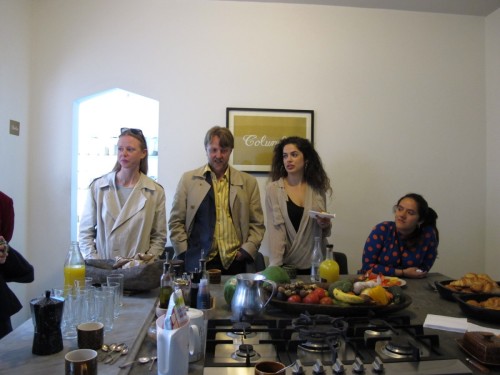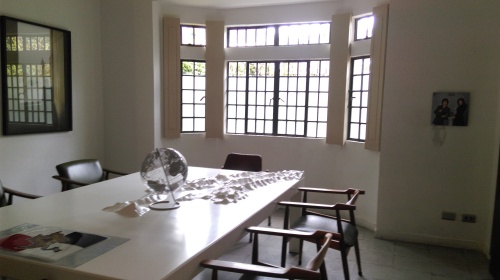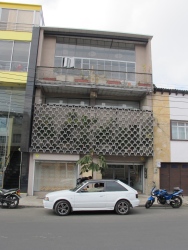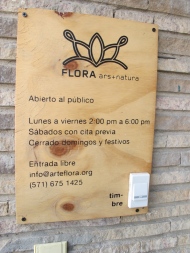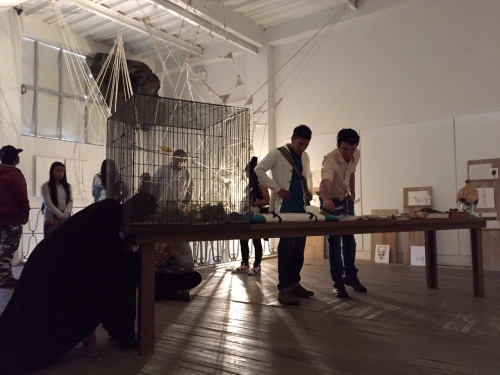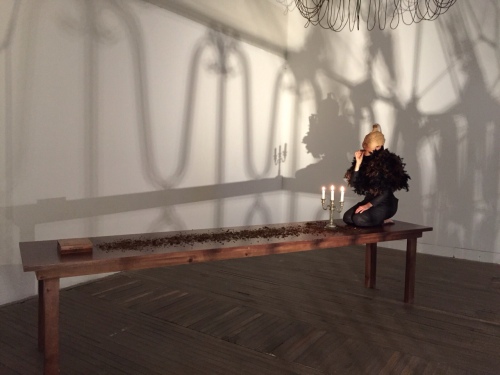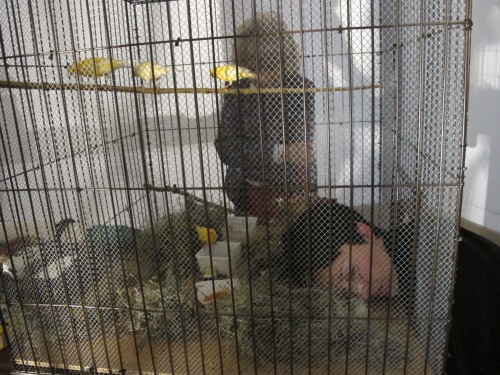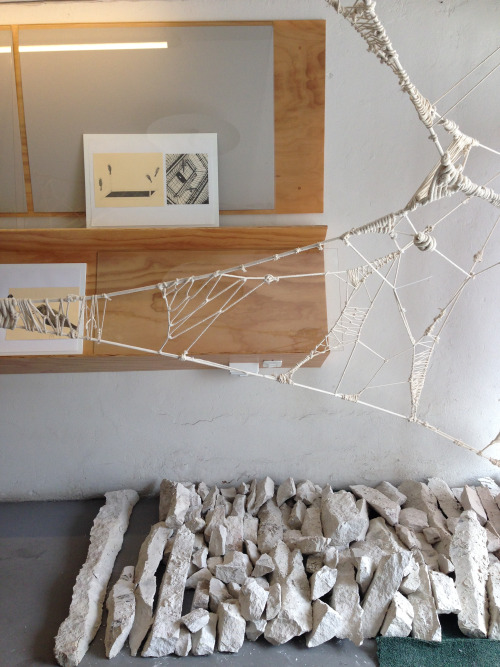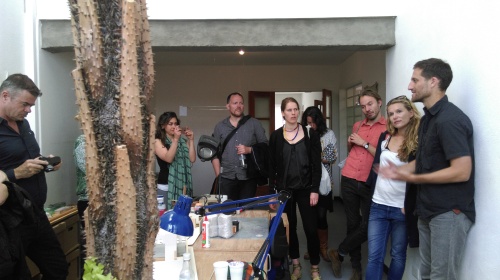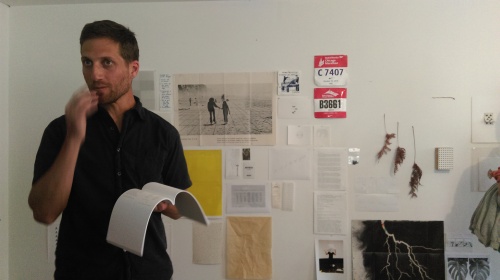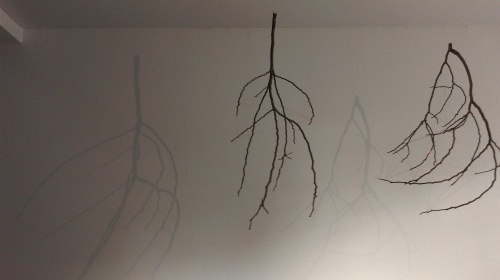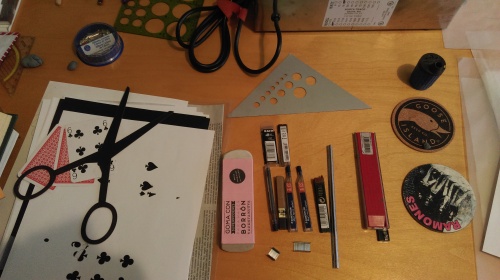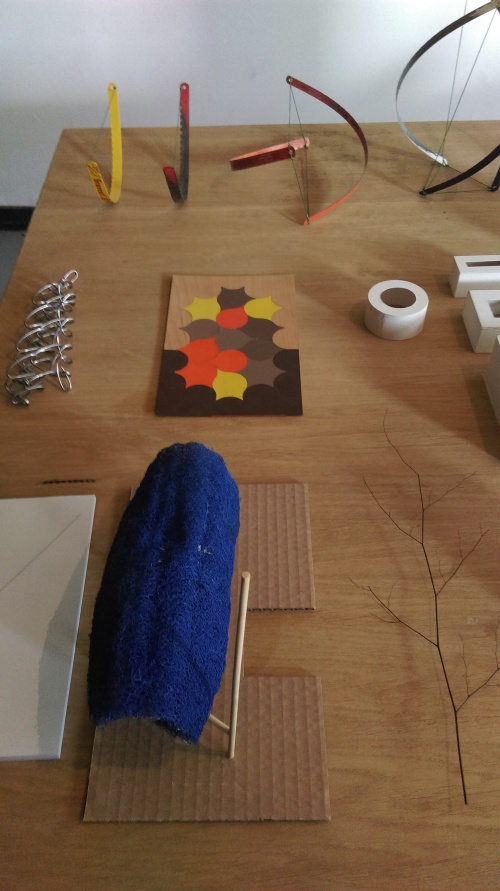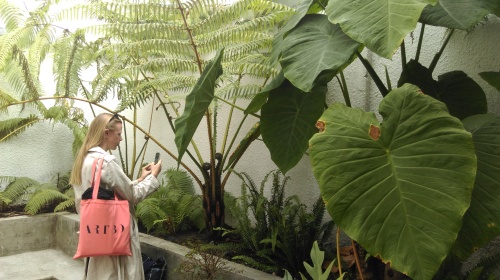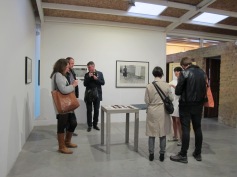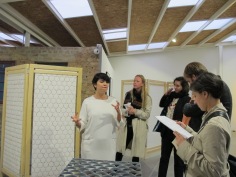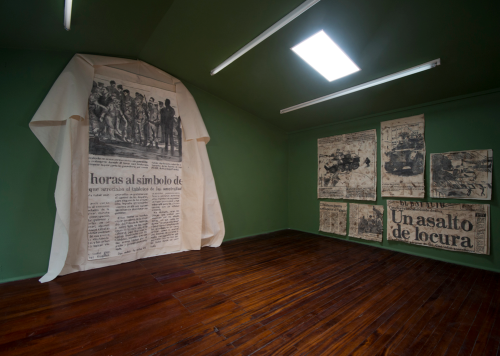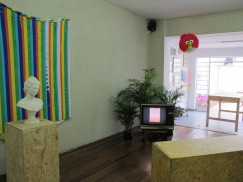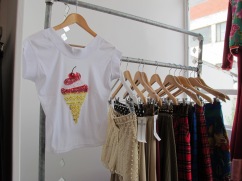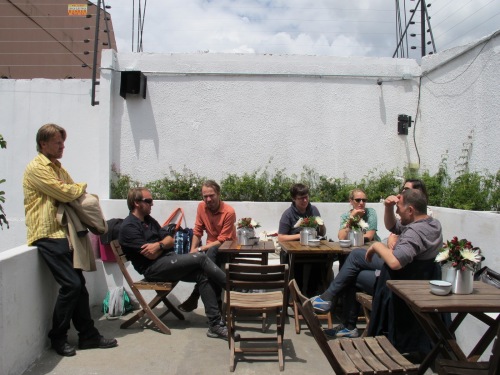Mas Arte Mas Acción
We were welcomed, around a plethoric breakfast, by a bunch of people in the very nice house that hosts the project Más Arte Más Acción. If several persons are part of the project today, “Más Arte Más Acción” takes its roots in the practice of one artist, Fernando Arias, who lives in this house with Jonathan Colin, his longtime partner and collaborator.
After an education in advertising and communication, Arias didn’t want to cope with capitalism and decided to engage into art to “give messages”. Critic about politics and society, he often uses the body as a symbolic vehicle that condenses larger issues.
In the middle of the 90’s, at the time when Colombia was suffering the worse decade of its recent past, Arias and Colin lived in London where they had good opportunities to develop their artistic work. As he wanted to reconnect with his country, Arias initiated a long travel from London to Patagonia, then to Choco, an isolated region in the rainforest on the Colombian western coast – then London again. This one month stay in Choco was a revelation and after several years of reflection Arias and Colin decided, in 2006, to go and live there. Indeed, even if their life in London was comfortable, they were seeking to build more meaningful projects. And Choco seemed to be the perfect place to fulfill that wish!
Much like an island, the territory is boarded by the impenetrable jungle, the ocean, the Andes and Panama on the north; the nature there is extreme and its movements are intense and excessive; its inhabitants, native indigenos or Afro Caribbean from the coast, are largely neglected by the Colombian authorities and almost powerless to defend their rights facing the multinationals that are interested by the amazing resources of the forest (specially precious metals).
From 2006 to 2009, Arias and Colin lived in a cabin with no internet or other access; they felt strongly reconnected with nature, they had books, reread Thomas Moore and worked around the novel Utopia. In this period, they realised the project Casa Chocolate in the village Nuqui, a cultural centre for local communities.
In 2011, they invited the Dutch architect Josep van Lieshout to think of a “shelter” that could host activities and protect from the surrounding nature’s excesses. Since then, the project “Más Arte Más Acción” welcomes artists who engage in a dialogue with nature and the local communities in Choco. The dancer Nemesio Berrio, for instance, developed a new work through workshops with local people and a close observation of nature, while Marie Ange Bordas, an artist anthropologist, worked with indigenes and children around the question of map and territory.
Parallel to the activities in Choco, the project expanded to the centre of Bogotá, in the very same house where we meet Arias, Colin and their colleagues. This responded to a need to have an operational centre and a platform for debate. The project has significantly grown and proposes various types of activities: residencies, workshops, educational programs with communities, among others.
Since recently, “Más Arte Más Acción” is also part of Arts Collaboratory, a large international program that was initiated in 2007 by two Dutch foundations DOEN and Hivos and supported by the Mondriaan Fonds and others. With the aim to support the exchange of ideas and working methods between socially engaged structures, this networking platform counts 23 members from all around the world, specially South America, Asia and Africa. Their common dream “is to generate social change through and beyond art” and they use Utopias as a tool to think and create. Casa Tres Patios and Platahedro, that we met in Medellin, are also part of the platform.
In 2016, Thomas Moore’s “Utopia” will celebrate its 500th anniversary; this will be the occasion to articulate a series of reflections and research that will take the form of publications. Utopia, dystopia and imaginary places, somewhere between the jungle, the urban house and the books…
Flora ars + natura
Flora ars+natura is a contemporary art space in Bogotá that focuses upon the relationship between art and nature. Through exhibitions, residencies and an educational program encounters between botany and sociopolitical issues are addressed. Although the green governs in Flora, this does not entail a celebration of Colombia’s bio-diversity. Flora and fauna, instead, are allegories for national struggles and hardship such as drug trafficking, violence and pollution.
At the time of our visit, the exhibition “Avistamiento ” by Maria José Arjona was on display. Drawings, videos, installations and performances of and by birds spread out over the two floors of Flora, turning it into a hybrid of a birds nest and an exhibition space. This temporarily living together of human being and bird followed on Arjona’s intense bird observations. Five years ago she started turning her head towards the New York sky in Central Park. Together with expert birdwatchers she observed birds and analyzed their behaviors with regard to themes like climate change.
The Buteo Swansoni particularly drew her attention. This eagle and Arjona had similar migratory habits, and both had been travelling in more or less the same directions. Now the time had come for them to reach their final destination. After having spent 16 years abroad, Arjona would, together with these birds, return to her homeland. But their return to Colombian soil was not the only thing Arjona and the eagle shared. “Avistamiento” refers to the common ground, and sky, between humans and birds. “There are many things humans and birds have in common”, says Arjona, “both are looking for things, searching one another, and being surprised by one another.”
Stephanie Noach
Rumor is one of the favorite tools of Nicolas Páris, and so was it with us: are we going to meet him or not? We finally made it on Friday when we were in his neighborhood. His house and studio is located in San Felipe, a neighborhood on the way to gentrification: several galleries are around and one recently opened just next door. Páris lives in the area since 2004 and since 2011 in this house where he receives our group, a place where he lives and works, his laboratory.
One key for the artist’s practice is indeed the relational aspect, even
though he doesn’t make “relational” art in Bourriaud sense. Páris works very often with groups of people, and uses the format of the workshop as a way to generate new ideas and to speculate on topics that he initiates. He says “collaboration is not the end, just the beginning. The end should be more ambitious”.
The end is then maybe something between the formal results and the traces that the work leaves in the memory. The form is really important in the work of the former architect, who taught us the concept of “knolling”, an English word for ordering straight, 90° angle; every little space in the house is super ordered and seems to be the result of a composition!
Ephemeral places of exchange instead of building “in hard”, that’s what Páris chose when ending his architecture studies. Another aspect, central to his work, is his one-year experience, in 2000, as a teacher in a rural village in Colombia, that he had to stop because of the guerrilla, and the educational program he set up afterwards in an isolated area, where the Andes, Orinoquia and Amazon join together.
More than 10 years after, he is still working on what he discovered there, specially reflecting on learning processes and ways to share knowledge. Having worked in areas where education was not the main priority is probably a reason for Páris to continue his engagement to develop educational programs as integral part of his works.
Ferns unfold in the studio of Páris: he started collecting them 2 years ago and has now numerous species. This relates to a research he is currently doing in order to understand how nature grows, which forms it takes, which rules it follows. The project will be developed in an exhibition at NC-arte next year, as well as in a pavilion that NCarte will realize on the roof of the new building of Flora ars + natura.
For now, Páris will leave soon for Lisbon where he has a solo show at Museo Berardo. He will show a room of videos that we couldn’t unfortunately watch because we were running out of time!
If his work seems somehow evanescent because of its ephemeral and
minimal aspect, Nicolas Páris is super structured, knows where he wants to go and how: “Drawing is my tool, education my system, architecture my method”.
Isaline Vuille
Istituto de Visión
Instituto de Visión is a space for research, experimentation and exchange between local and international artists, markets, and cultural agents.
The program is focused on conceptual practices that propose micro-revolutions, original perspectives and personal ecosystems inserted into a specific context.
The poetics that inspire the institution originate in interchange, tropicality, decoding, cotidianity, archives and historic revision.
Trough the program Visionarios, Instituto de Vision aims at revisiting the history of Colombian art to give a position to artists who remained, despite their challenging and committed posture, alienated from the academic / official recount of Colombian Art History.
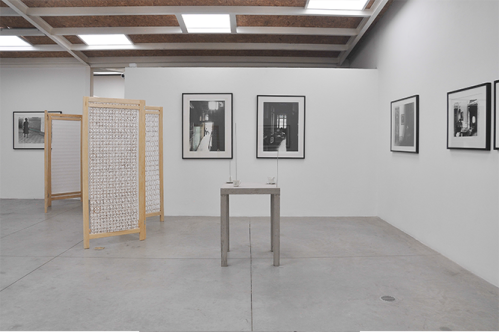
Felipe Arturo,Demoliciones, 2015. y Fotografías en blanco y negro pintadas a mano por Fernell Franco de la serie: Interiores de 1990 y ca.1974-80.
Through the program Visionarios, Instituto de Vision, undertakes an historical revision of artists from the mid XX century, who, through their innovative and bold visions, introduced transcendental changes in the art practice of Colombia, remaining nevertheless outsiders from art history. With a program of publications and exhibitions, Instituto de Vision wants to present an integral history, beyond a classification based on market success, to recover those visions, which were not giv- en their deserved positions.
Within this program, they are working with artists such as Fernell Franco, Luis Ernesto Arocha, Sandra Llano-Mejía, Nereo López, Alicia Barney, María Evelia Marmolejo, Miguel Ángel Cárdenas, among others.
SKETCH ROOM
Located in San Felipe-area, Bogotá’s new art district we find SKETCH ROOM gallery which reveals its motive in its name: a contemporary space dedicated to paper and various form of drawing.
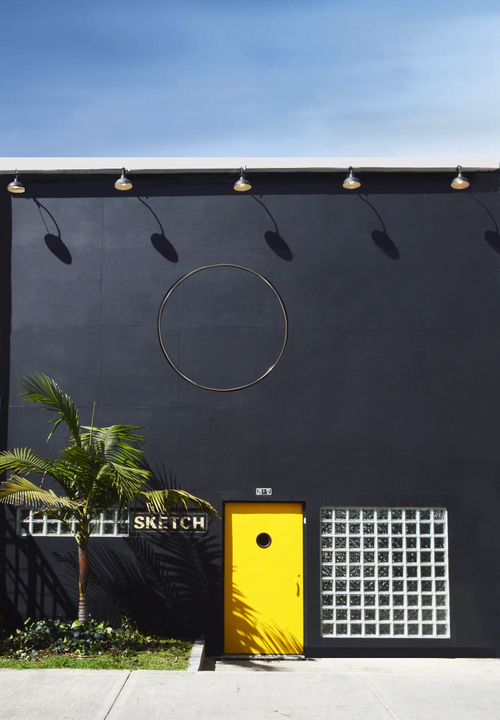
The gallery facade painted black for artist Giovanni Vargas’ wall mounted circular bronze sculpture “Con la punta del dedo”
Returning to Colombia after several years in the UK, Liz Caballero founded the gallery only two years ago in 2013 and has since then created a space, which not only features exhibitions, but also serves as a central Bogotá meeting point for artists and art professionals. The gallery – as for now – represents only Latin American artists, all quite young and emergent. However as Liz explains, the current Latin American focus, has more to do with long distance shipping costs than with a determined gallery strategy. The gallery is young and the long term plan is to be a leading exhibition space also on the international market. Only two yera old SKETCH has already made a name for itself and is also participating in the ARTBO fair.
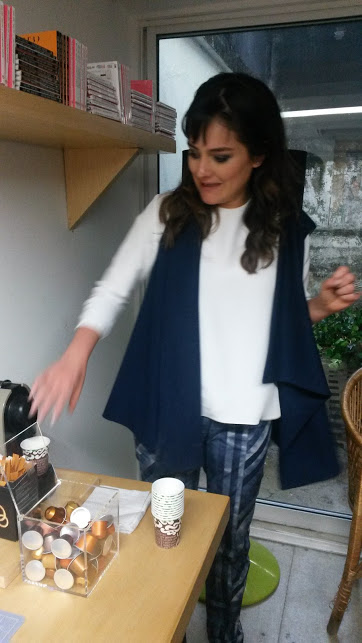
Founder and director Liz Caballero welcomed a group of rain wet Orientation Trippers with comforting warm coffee and a thorough introduction to the gallery profile
SKETCH is currently showing three exhibitions, all by younger Colombian artists: Giovanni Vargas (1976): Con la Punda del Dedo (ed. With the tip of the Finger); Felipe Uribe (1982) – “Repeticiones Inútiles, Sueña En Grande No Hagas Nada” (ed. Useless Repetitions, Big Dreams, Doing Nothing); Andres Felipe Orjuela (1985) 27 Hrs Palomas Y Piedras (ed. 27 hrs Doves and Stones).
Con la Punda del Dedo by Giovanni Vargas
Already before entering the gallery we can see, that SKETCH’s approach to drawing is more of a experiental kind as the usually white facade of the gallery is integrated in one of the current exhibitions. Now in black the facade serves as a dramatic back cloth for artist Giovanni Vargas’ wall mounted circular bronze sculpture “Con la punta del dedo” (ed. With the fingertip) – also the title of the entire show.
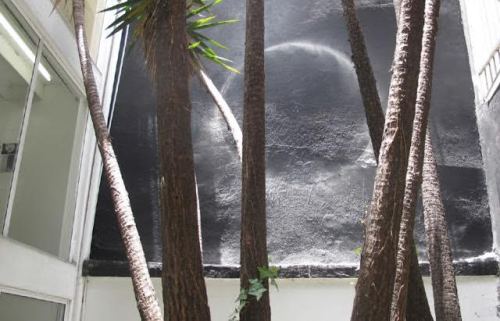
The gallery courtyard as been included in Vargas’ the exhibition as well as the facade. In one end the work “With the tip of the finger” (bas-relief on wall) and opposite “Sol Cegador” (ed. Blinding Sun), “drawn” with filament heat wire.
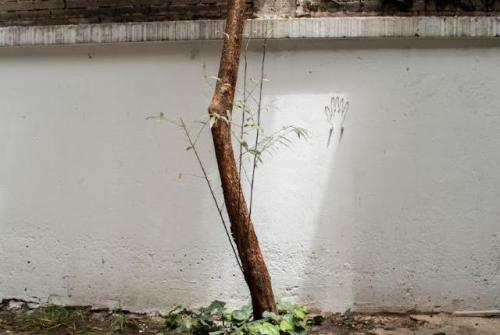
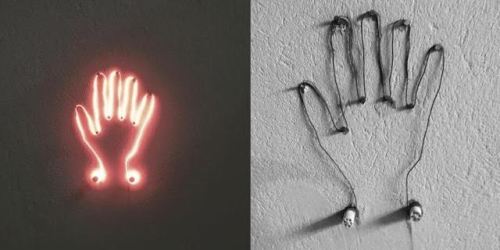
Giovanni Vargas: Sol Cegador (ed. Blinding Sun), Drawing on wall (Filament, Heat Wire), 20 x 7.5 cm. Courtesy Sketch Gallery.
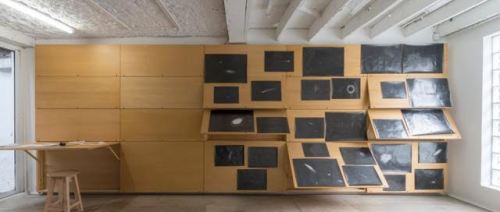
Inside the gallery we find the work “The Visions of Caroline Herschel”, densely drawn graphite paperworks, referring to the 19th century astronomer Caroline Herschel – the first woman to discover a comet.
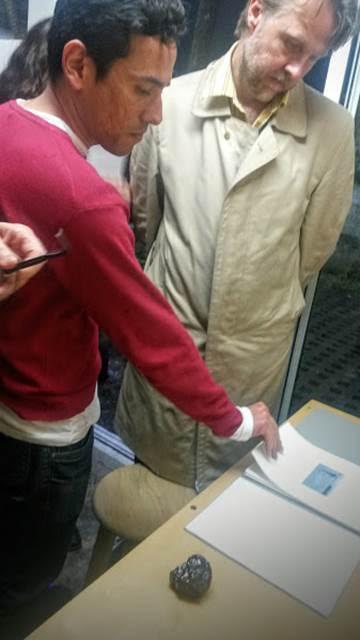
Giovanni Vargas introducing the work “Caídos del cielo” (ed. Godsend / fallen from the sky) – a leaf book containing 61 images of places where meteorites and an actual meteorite.
27 Hrs Palomas Y Piedras by Andres Felipe Orjuela
On the gallery’s 3rd floor we find Andrés Felipe Orjuela’s (b. 1985) exhibition ”27 hrs – Palomas y Piedras” (ed. 27 hrs Doves and Stones), featuring several works of ink and charcoal on a specially fabricated Mexican bark paper.
In Orjuela’s work we once again encounter an artistic investigation of Colombia’s violent past, as he has reproduced graphic newspaper clippings covering the guerrilla group M-19’s 1985 siege of the Supreme Court of Colombia. The 27 hour siege involved the hostage taking of some 300 lawyers, judges, and magistrates and led to the mobilization of armed military forces, resulting in heavy crossfire, and ultimately the death of more than 100 people. An important fact however, is that the involved guerrillas only counted ca. 30, and thus controversy still exists around what actually occurred, and what parties were involved.
On the end wall one drawing reads “Un asalto de locura” (ed. An assault of madness), underlining the two key elements at play 1) human madness 2) acted out violently.
Orjuela resides in Mexico (another country afflicted by a high degree of violence) and has enlarged the clippings to monumental sizes to raise awareness both of the injustice and the violence, but also of the news media’s endless and over-graphical representation of this violence. The media’s role and responsibility in this context is a reoccurring theme in Orjuela’s practice, which in many cases describes not only how violence breed violence, but how “media violence” contributes to the ever more sadistic and barbaric spiralling of actual violence.
Ane Bülow
Art, Cloth & Drinks at KB – espacio para la cultura

